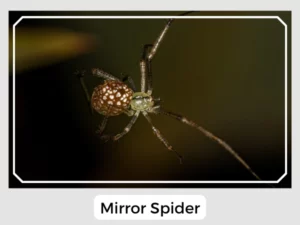The mirror spider is a special creature from Australia. It has shiny scales on its back that look like tiny pieces of mirror. That’s why it’s called the “mirror spider”. In this post, we’ll share some cool facts about this unique spider.
The mirror spider lays small, round eggs. While specific details about their color are not well-documented, they are a crucial part of the spider’s life cycle.
The young spiders are rare, so facts about their description remain unrecorded. However, like many spider species, they typically disperse from their siblings upon reaching maturity.
Mirror spiders are known to spin tangled webs in secluded, undisturbed locations, providing them with a safe space to reside and catch their prey.
Yes, Mirror Spiders, like many spiders, have venom. But their venom is mostly for catching tiny bugs to eat and isn’t harmful to humans.
Mirror Spiders can bite, but they usually only do so when they feel threatened. Most of the time, they’re peaceful and keep to themselves.
The mirror spider plays a vital role in controlling insect populations, feeding on small bugs that it captures in its web. This not only benefits the spider but also contributes to the ecological balance of its habitat. The spider’s reflective scales are not just for show; they serve as a defense mechanism. When threatened, the spider can alter the size of its scales, creating a dazzling display that can deter predators and protect the spider from harm.
Natural Predators: Despite their brilliant defense mechanism, mirror spiders are not without their natural predators. Birds and larger insects pose a significant threat, preying on these small spiders when given the chance.
Prey-Predator Dynamics: The mirror spider’s life is a delicate dance of predator and prey. It relies on its ability to catch insects for food, while also evading larger predators that see it as a meal. This intricate interaction plays a crucial role in maintaining the balance of the ecosystem.
Relationship with Humans: Mirror spiders are generally harmless to humans. Their venom is designed for subduing small insects and is not harmful to people. While they can bite if they feel threatened, such instances are rare, and the spiders prefer to keep to themselves, living peacefully in their secluded webs.
| Other Names | Twin-peaked Thwaitesia, sequined spider |
| Distribution | Australia |
| Habitat | Leaves, trees |
| Diet | Insects |
| IUCN Conservation Status | Not Listed |

In conclusion, the mirror spider stands as a shining example of nature’s wonders, showcasing the beautiful ways in which creatures adapt to their environments. With its dazzling scales and delicate size, it captures the essence of nature’s artistry.
The mirror spider is a special creature from Australia. It has shiny scales on its back that look like tiny pieces of mirror. That’s why it’s called the “mirror spider”. In this post, we’ll share some cool facts about this unique spider.
The mirror spider lays small, round eggs. While specific details about their color are not well-documented, they are a crucial part of the spider’s life cycle.
The young spiders are rare, so facts about their description remain unrecorded. However, like many spider species, they typically disperse from their siblings upon reaching maturity.
Mirror spiders are known to spin tangled webs in secluded, undisturbed locations, providing them with a safe space to reside and catch their prey.
Yes, Mirror Spiders, like many spiders, have venom. But their venom is mostly for catching tiny bugs to eat and isn’t harmful to humans.
Mirror Spiders can bite, but they usually only do so when they feel threatened. Most of the time, they’re peaceful and keep to themselves.
The mirror spider plays a vital role in controlling insect populations, feeding on small bugs that it captures in its web. This not only benefits the spider but also contributes to the ecological balance of its habitat. The spider’s reflective scales are not just for show; they serve as a defense mechanism. When threatened, the spider can alter the size of its scales, creating a dazzling display that can deter predators and protect the spider from harm.
Natural Predators: Despite their brilliant defense mechanism, mirror spiders are not without their natural predators. Birds and larger insects pose a significant threat, preying on these small spiders when given the chance.
Prey-Predator Dynamics: The mirror spider’s life is a delicate dance of predator and prey. It relies on its ability to catch insects for food, while also evading larger predators that see it as a meal. This intricate interaction plays a crucial role in maintaining the balance of the ecosystem.
Relationship with Humans: Mirror spiders are generally harmless to humans. Their venom is designed for subduing small insects and is not harmful to people. While they can bite if they feel threatened, such instances are rare, and the spiders prefer to keep to themselves, living peacefully in their secluded webs.
| Other Names | Twin-peaked Thwaitesia, sequined spider |
| Distribution | Australia |
| Habitat | Leaves, trees |
| Diet | Insects |
| IUCN Conservation Status | Not Listed |

In conclusion, the mirror spider stands as a shining example of nature’s wonders, showcasing the beautiful ways in which creatures adapt to their environments. With its dazzling scales and delicate size, it captures the essence of nature’s artistry.